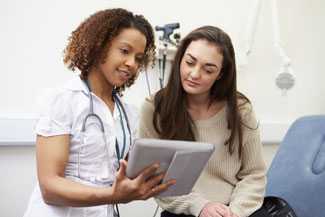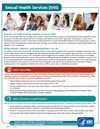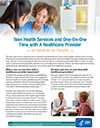Health Services for Teens

Teens in the United States are less likely than younger children and adults to receive recommended preventive health services in general. Schools can play a critical role in facilitating the delivery of health services to teens, including sexual health services (SHS). Although teens are generally healthy, sometimes they engage in sexual behaviors that put them at risk for certain health outcomes, such as HIV, STDs, and pregnancy. For instance, in 2014, young people (13–24) accounted for an estimated 22% of all new HIV infections in the United States,1 and nearly half of the 20 million new STDs reported each year.2 Among U.S. high school students surveyed in 2015, 41% had ever had sex and 43% of sexually active students did not use a condom the last time they had sex.3 Additionally, although teen pregnancy rates have declined consistently during the past 25 years, the rates of unintended pregnancy still remain high. One way to prevent HIV, STDs and pregnancy among teens is to increase their access to and use of SHS, including HIV testing, contraceptive counseling, gonorrhea and chlamydia testing and treatment, and Human Papillomavirus (HPV) vaccination.4,5
Several national guidelines for preventive care specifically include recommendations for SHS for teens. Despite these official guidelines and recommendations, teens may not seek or have access to recommended SHS. For instance, in 2015, only 10% of sexually experienced students reported having ever been tested for HIV,3 and a recent online survey of young people found that only 7% of 15-19 year olds had been tested for STDs in the previous year.6
Schools can help increase student access to health services

Schools have direct daily contact with more than 16.5 million students attending grades 9-12, making schools vital partners in connecting teens to health services.
School districts can help teens access SHS either through on-site school services or by referrals to youth-friendly health care providers in the community. Many U.S. schools already have healthcare service infrastructure in place, including school-based health centers (SBHCs) or school nurses, and can play an important role in providing adolescents access to information to help reduce their risk and to services if they are needed.
CDC recommends actions that school districts and schools can take to ensure students have access to key SHS through on-site services at schools, or off-site referrals to youth-friendly, community-based health service providers. SHS can be provided by or linked to SBHCs, school nurses, and community healthcare providers.
One of CDC’s key programmatic strategies is to improve schools’ capacity to increase adolescents’ access to key preventive SHS either by providing on-site services or making referrals to adolescent-friendly community-based health service providers. CDC provides program guidance on how to increase student access to SHS by encouraging schools to
- Help ensure student confidentiality;
- Increase awareness of adolescent sexual health needs by providing medically accurate information to district and school staff, community partners, and parents;
- Raise student awareness of the need for and availability of SHS (e.g., school-wide social marketing campaigns);
- Establish solid community partners that can help deliver SHS on-site or serve as a source of referral; community partners can assist with sexual health education or professional development trainings;
- Establish a referral system that helps link students to youth-friendly providers; and
- Provide SHS on-site by expanding or making current services more appealing to students or adding new services.
 Sexual Health Services (SHS) Fact Sheet
Sexual Health Services (SHS) Fact Sheet
This fact sheet is for school districts and education agencies and explains the importance of health care resources and increasing student access to preventive health services.
 Teen Health Services and One-On-One Time with A Healthcare Provider: An Infobrief for Parents
Teen Health Services and One-On-One Time with A Healthcare Provider: An Infobrief for Parents
This infobrief explains how parents can help create a trusting relationship by allowing their teen one-on-one time with their healthcare provider.
 Developing a Referral System for Sexual Health Services
Developing a Referral System for Sexual Health Services
References
- CDC. Diagnoses of HIV Infection in the United States and Dependent Areas, 2014. HIV Surveillance Report 2014, vol. 26; November 2015.
- CDC. Sexually Transmitted Disease Surveillance 2014. Atlanta: U.S. Department of Health and Human Services; 2015
- CDC. Youth Risk Behavior Surveillance—United States, 2015. MMWR 2016;65(SS-6).
- U.S. Preventive Services Task Force. Guide to Clinical Preventive Services. 2nd Edition. Alexandria VA: International Medical Publishing, 1996.
- CDC. Revised Recommendations for HIV Testing of Adults, Adolescents, and Pregnant Women in Health-Care Settings MMWR 2006;55:1-17.
- Cuffe KM, Newton-Levinson A, Gift TL, McFarlane M, Leichliter JS. 2016. Sexually Transmitted Infection Testing Among Adolescents and Young Adults in the United States.J Adolesc Health; 58(5):512-9
- Page last reviewed: February 15, 2017
- Page last updated: February 15, 2017
- Content source:


 ShareCompartir
ShareCompartir